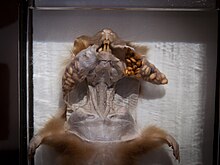Cheek pocket

The cheek pouch (lat. Saccus paraoralis ) is a blind to a bulging of the cheeks mucous in hamsters . The pockets extend on both sides along the lower jaw to behind the shoulder blade and lie directly under the skin. The golden hamster has a capacity of around 20 g, while the brown hamster can hold up to 50 g.
The opening of the cheek pouch is at the corner of the mouth at the level of the toothless gap in the dentition . There a triangular skin field turns inwards, which closes the cheek pouch towards the oral cavity when the mouth opening is closed. The cheek muscle , which serves as a sphincter, radiates into the wall of the opening . The cheek pouch retractor muscle ( Musculus tensor sacci paraoralis ) arises from the last two thoracic vertebrae and radiates into the cheek pouch from behind and above (dorsocaudal).
On the rear inner wall of the pockets there is a strongly folded fabric protruding forward. This allows the pockets to enlarge when food is ingested. The strongly developed salivary glands - especially parotid and mandibular salivary glands - act as lubricants during transport in and out of the cheek pouches.
In the case of improper feeding with sticky feed, hamsters often clog the cheek pouches, which then have to be cleared out manually. Secondarily, a cheek pouch prolapse can then occur.
literature
- Chris Logsdail et al .: Hamsterlopaedia. A Complete Guide to Hamster Care . Ringpress Books, Dorking, 2005. ISBN 1-86054-246-8
- Anne Schultze: Anatomical peculiarities of the golden hamster (Mesocricetus auratus auratus) . In: Salomon et al. (Ed.): Anatomy for veterinary medicine . Enke Stuttgart. 2nd ext. 2008, pp. 735-740. ISBN 978-3-8304-1075-1
Individual evidence
- ↑ James M. Ryan: Comparative Morphology and Evolution of Cheek Pouches in Rodents . In: Journal of Morphology . tape 190 , no. 1 , 1986, ISSN 0362-2525 , pp. 27-42 , doi : 10.1002 / jmor.1051900104 .
